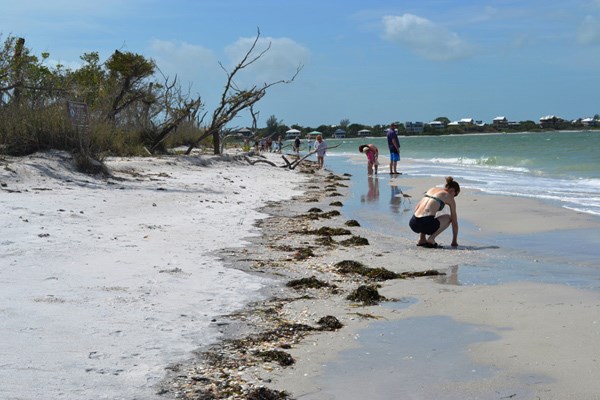Sanibel. The word dances off the tongue like a magical destination straight out of a Tinkerbell story. Which is fitting, because there is something very magical and fairytale-like about Sanibel, one of the causeway islands in Southwest Florida.
For one thing, there are no highrises on this cusp of land that extends like a big, asymmetrical grin in the Gulf of Mexico. No big box stores, massive malls or even traffic lights. Drive over the graceful, arched bridges that separate Fort Myers from Sanibel and you leave reality behind, entering a community where biking trails are ubiquitous, conservation is the keyword, and pristine, shell-soaked beaches are just a normal part of everyday life.
It's the shell-hunting we've come for. The location of the causeway islands coupled with the movement of the tides means that an exquisite array of shells washes up on Sanibel's beaches each day.
Finding them means long walks on the soft white sand, with eyes peeled to the ground and frequent stops to unearth and inspect an eye-catching shell. Back at our hotel, we use a sheller's identification guide to separate bivalves from univalves, conches from whelks.
And later, at the Bailey-Matthews Shell Museum we gawk at the immaculate specimens others have foraged from Florida's beaches: the brilliant, fiery orange hues of the lion's paw and the graceful curvature of the lightning whelk.
Behind glass cases we see the exquisitely symmetrical spots of the dubious volute, and the sharp spines of Paz's murex. The beaches are a graveyard for offshore sea creatures uprooted by stormy seas, and any shell devoid of an occupant is fair picking.
The word "paradise" is tossed around a lot on Sanibel, and you don't have to look far to see why. Twenty miles of biking trails wind around the island, past lush, tropical foliage, mom-and-pop restaurants and mangrove trees that stick hundreds of toes into the salty water.
With 70 per cent of the island reserved for conservation and wildlife refuge, the human footprint is relatively unobtrusive here. A family vacation in Sanibel is about cavorting in the warm surf of the Gulf, building elaborate sand sculptures and hunting for the trophy shells that literally litter the beach.
It's also about wildlife watching. We drive a half hour north of Sanibel to Captiva Island, to board a ferry to Cabbage Key. Before we can do that, though, we're distracted by a breathy snorting sound coming from the water lapping against the marina's pier.
Several sets of grey nostrils are visible above the surface, the only evidence of the manatee family feeding on seagrass just meters from where we're standing.
The 1,300-pound manatee cows, bulls and calves are gentle giants of the sea who spend their lives gorging on seagrass in warm water.
Relatives of the elephant family, they share a grey skin and a mammoth girth, but unlike their land-based family, the manatees move slowly and cannot defend themselves. One bears scars from the boat propellers that sadly, cause the demise of many a manatee in Southwest Florida.
On board the Captiva Cruises ferry, more wildlife is minutes away as dolphins dip and dive in the vessel's wake and a wide variety of sea birds fly around us.
Ospreys are almost as numerous and vocal as seagulls, grabbing fish from the gulf and trailing it in their talons to their nests. We see pelicans diving headfirst into the ocean, egrets and herons standing stockstill in the shallows and giant frigate birds suspended on the thermals as if attached to the string of a long kite.
Back on Sanibel we take a guided tour through one of the nation's busiest refuges, the 6,000-acre "Ding" Darling national wildlife refuge.
Here, we learn how mangrove trees have anchored the causeway islands in place, preventing hurricanes from tearing the islands to shreds and creating invaluable habitat and nutrients for aquatic life. We watch tree crabs scurry over mangrove branches, ospreys feed their young and egrets as they catch their next meal. We also learn about the 11-foot American crocodile that once called Sanibel home.
"She lived quite happily in the "Ding" Darling refuge until folks starting feeling sorry for her," says Barry Litofsky, our naturalist. "They felt she should be with other crocs, so she was caught and relocated 60 miles away."
Just months later, that old croc was back, though. A popular fixture at the refuge, she stayed there until her death in 2010.
Travel Writers' Tales is an independent travel article syndicate that offers professionally written travel articles to newspaper editors and publishers. To check out more, visit www.travelwriterstales.com.
IF YOU GO
- For general information, visit www.fortmyers-sanibel.com or call (800) 237-6444.
- To reach Cabbage Key, rent a boat or take a day-long excursion with Captiva Cruises (www.captivacruises.com, (239) 472-5300). The restaurant at Cabbage Key serves breakfast, lunch and dinner. Its owners, the Wells family, also rent rooms with full kitchens. Info: www.cabbagekey.com, (239) 283-2278.
- Tarpon Bay Explorers offers guided tours of the J.N. "Ding" Darling national wildlife refuge. Info: www.tarponbayexplorers.com, (239) 472-8900.
- Try Doc Ford's (www.docfords.com) and Jacaranda (www.jacarandaonsanibel.com) for two unique island restaurants.



